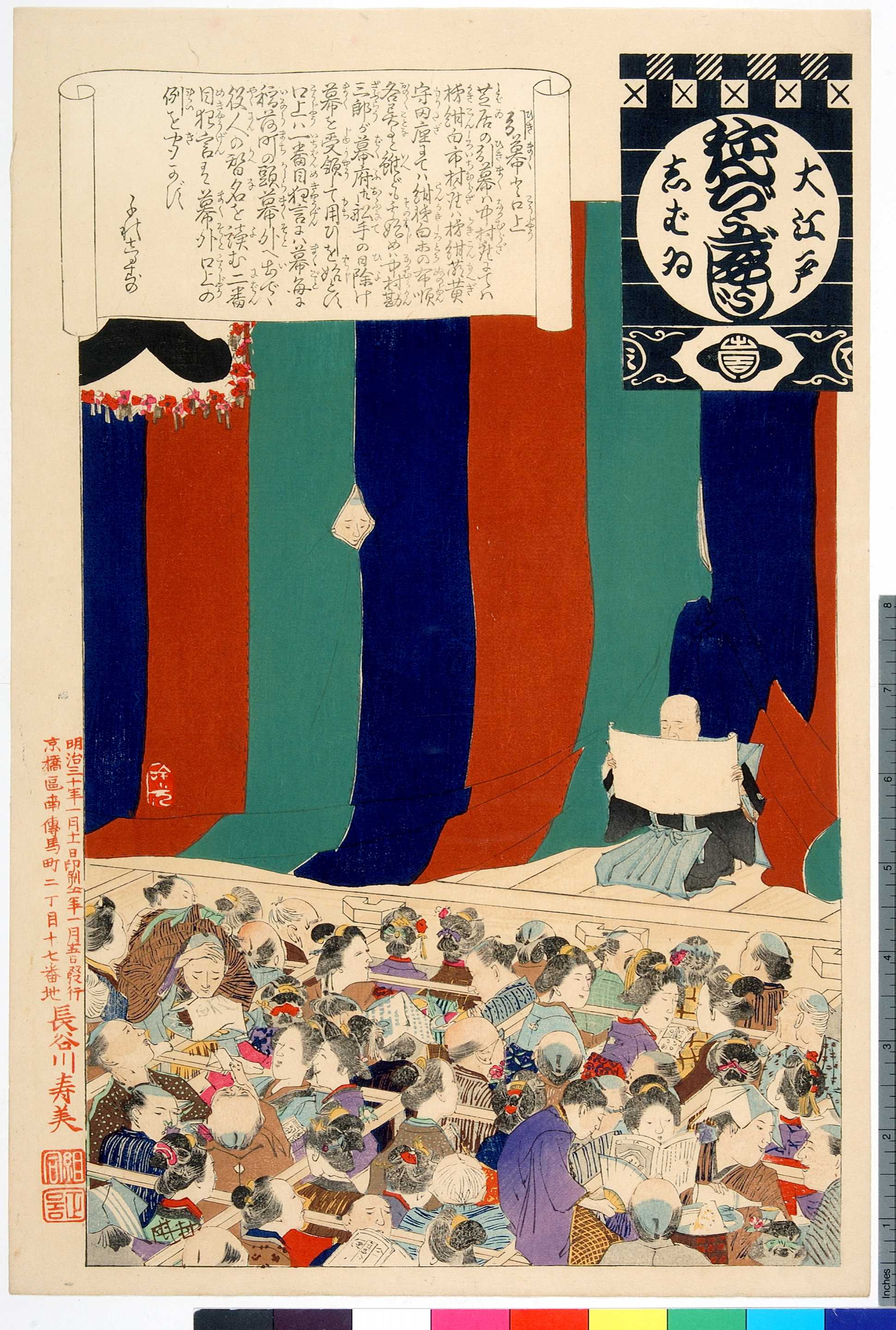B11 Circumstances of Auditorium
-
Ō-Edo shibai nenjū gyōji "Hikimaku, Kōjō"
Ōban, Colour print
Artist: Adachi Ginkō; Published: Meiji 30 (1897) by Hasegawa Sumi
Ritsumeikan Art Research Center (arcUP2050)During a kōjō, a theatre representative or actor, seated on the stage, called out greetings to the audience. Today, kōjō usually refers to a separate item on the program for announcing the new stage names actors take as they progress through their careers. Such actors, with those in their family of actors appearing together in plays of a current production, align themselves on stage and take turns addressing the audience. In earlier days, kōjō had a broader range of purposes, including announcing stage debuts or memorial performances, and the kōjō would often be inserted during an interruption in the progress of the play. In the Edo Period, there were kōjō to introduce the roles and actors at the start of each act of the play, though this occurred primarily for "period" plays (jidaimono, ichibanme), not for "domestic" plays (sewamono, nibanme).
In the large licensed theatres of the Edo Period, the draw curtain (hikimaku) was used instead of a drop curtain (donchō). The small theatres weren't permitted the use of the draw curtain, but they did use the drop curtain. For this reason, they were sometimes referred to as "drop curtain theatres" (donchō shibai). There were two types of draw curtains, the standard (jōshikimaku) and the celebratory or gift curtain (iwaimaku or okurimaku). Celebratory curtains are draw curtains given as gifts from patrons to the troupe leader or to individual actors or playwrights, especially at times of memorial productions. Actors vied with each other over who received the largest number.
The standard curtain consists of strips of three colors of cloth sewn together in alternating vertical stripes. Its origin is said to be a sail from the official shogunate boat Antokumaru. In gratitude for helping synchronize rhythmic rowing on the boat, actor Nakamura Kanzaburō I (1598-1658) was gifted the sail. A reddish-brown or persimmon color was later added. The standard curtain colors and ways in which they are combined vary with the theatre. In the Nakamura Theatre, the colors in alternating order were black, persimmon, and white. For the Ichimura Theatre, it was black, persimmon, and yellow-green, and for the Morita Theatre, it was yellow-green, persimmon, and black.
Early on, when kabuki was performed on the noh stage, curtains weren't used, but most likely, as kabuki plays became increasingly complex, the rapid succession of scenes necessitated set changes, which in turn led to the use of curtains. One could also venture that the agemaku (entrance curtain) of the noh stage was re-purposed.
This print is an excellent depiction of the sectional seating (masu) on the ground floor (doma) of a kabuki theatre. Each sectioned-off area could seat six people, and old and young, men and women mixed together. Before the curtain opened, wine and food could be delivered from the theatre teahouses by men using the raised walkways running through this sectioned seating area. As is still true today, illustrated programs (ehon banzuke) were sold in the theatre, and cast lists (yakuwari banzuke) were given out. We can see audience members pouring over them in this print. Gaining a view out onto the audience from openings at the seams of the curtain, theatre staff could get a feel for the house, as is also charmingly illustrated here.
[Glossary]
Shibaichaya、Nakamura Kanzaburo、Inarimachi、Yakuninkaena、Banzuke
[Related Topics]
「Theatres and promotion」 -

- 投稿日:
- by 8P
- カテゴリ: B Front and Back of Kabuki Stage
- [編集]